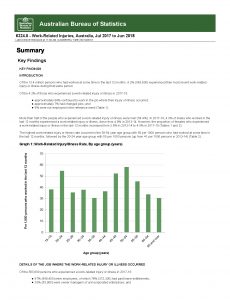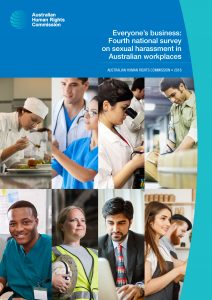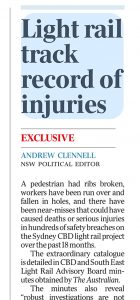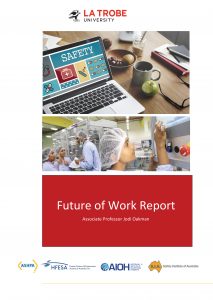 In late October 2018, the Australian Bureau of Statistics (ABS) released a summary of the latest work-related injury and illness data, although it was easy to miss as few, if anyone, reported on it. On first view, that mental health is barely mentioned in the Summary is surprising and the workers compensation data raises interesting policy questions.
In late October 2018, the Australian Bureau of Statistics (ABS) released a summary of the latest work-related injury and illness data, although it was easy to miss as few, if anyone, reported on it. On first view, that mental health is barely mentioned in the Summary is surprising and the workers compensation data raises interesting policy questions.
Category: statistics
Is OHS suffering from policy AND structural capture?
 The Grattan Institute has released a report about the political influence of lobbyists. Understandably the media is giving the report a lot of attention, particularly as it identifies lobby groups that have more access to politicians than other groups and how public interest policies have failed after intense lobbying. But the report also addresses the matter of “policy capture”. Although the report analyses the activities of lobbyists, perhaps research could be undertaken into the high level of policy influence on workplace health and safety matters from a tripartite consultative structure that no longer reflects the Australian workforce.
The Grattan Institute has released a report about the political influence of lobbyists. Understandably the media is giving the report a lot of attention, particularly as it identifies lobby groups that have more access to politicians than other groups and how public interest policies have failed after intense lobbying. But the report also addresses the matter of “policy capture”. Although the report analyses the activities of lobbyists, perhaps research could be undertaken into the high level of policy influence on workplace health and safety matters from a tripartite consultative structure that no longer reflects the Australian workforce.
In its Overview the Grattan Institute writes:
The sexual harassment you walk past is the sexual harassment you accept
 Australian Human Rights Commissioner, Kate Jenkins, has released the findings of the Commission’s latest survey on sexual harassment in workplaces. It is an important analysis of an improving dataset that should make actions to prevent sexual harassment more effective.
Australian Human Rights Commissioner, Kate Jenkins, has released the findings of the Commission’s latest survey on sexual harassment in workplaces. It is an important analysis of an improving dataset that should make actions to prevent sexual harassment more effective.
The statistical report is separate from the Commission’s National Inquiry into Sexual Harassment in Australian Workplaces and does not emphasise the role of harm prevention but it does contain references to prevention that are worth considering.
Workplace Health Management programs save one hospital around $200k
 It is always good to see researchers assessing issues related to workplace health and safety rather than relying on overseas data. Recently researchers from the Australian Catholic University and St Vincent’s Hospital in Melbourne looked into “measuring the effectiveness of workplace health management programs” . The research adds to our understanding of these programs but the relevance to occupational health and safety (OHS) is limited.
It is always good to see researchers assessing issues related to workplace health and safety rather than relying on overseas data. Recently researchers from the Australian Catholic University and St Vincent’s Hospital in Melbourne looked into “measuring the effectiveness of workplace health management programs” . The research adds to our understanding of these programs but the relevance to occupational health and safety (OHS) is limited.
The researchers,
Front page OHS article gives half the story
 Years ago I was advised how to read a newspaper article – the first two paragraphs and the last. The exclusive front page article in The Australian ($ paywalled) on August 15 2018 about occupational health and safety (OHS) management at Sydney’s light rail construction project is a good example of what journalists choose to write and what they are obliged to write.
Years ago I was advised how to read a newspaper article – the first two paragraphs and the last. The exclusive front page article in The Australian ($ paywalled) on August 15 2018 about occupational health and safety (OHS) management at Sydney’s light rail construction project is a good example of what journalists choose to write and what they are obliged to write.
“A pedestrian had ribs broken, workers have been run over and fallen in holes, and there have been near-misses that could have caused deaths or serious injuries in hundreds of safety breaches on the Sydney CBD light rail project over the past 18 months.
The extraordinary catalogue is detailed in CBD and South East Light Rail Advisory Board minutes obtained by The Australian.”
and
The future of work and OHS – yeah, but…..
 ASHPA, the Australian Safety and Health Professional Associations has been quiet for a while but sponsored La Trobe University to undertake some research into the future of work and its impacts on occupational health and safety (OHS) professionals, hygienists, ergonomists and others. It is an interesting insight into the thoughts and perspectives of safety and health professionals but it also cries out for interpretation and analysis.
ASHPA, the Australian Safety and Health Professional Associations has been quiet for a while but sponsored La Trobe University to undertake some research into the future of work and its impacts on occupational health and safety (OHS) professionals, hygienists, ergonomists and others. It is an interesting insight into the thoughts and perspectives of safety and health professionals but it also cries out for interpretation and analysis.
The report, not yet available online, is based on the responses of 733 safety and health professionals to an online survey. The statistical profile of the profession in Australia is useful and the key findings
Is workers’ compensation less important than other insurances?
 In late July 2018, the Victorian Auditor-General Office (VAGO) released a report into the insurance risks of several Victorian local councils. It is reasonable to expect the costs of workers’ compensation insurance to be addressed in the report but this was not the case. Although it is clearly an insurance product, the Auditor-General excluded workers’ compensation insurance. This position continues to sideline workers’ compensation implying to Victorian Councils, if not businesses, that it is less important than other business insurances.
In late July 2018, the Victorian Auditor-General Office (VAGO) released a report into the insurance risks of several Victorian local councils. It is reasonable to expect the costs of workers’ compensation insurance to be addressed in the report but this was not the case. Although it is clearly an insurance product, the Auditor-General excluded workers’ compensation insurance. This position continues to sideline workers’ compensation implying to Victorian Councils, if not businesses, that it is less important than other business insurances.
The best example of this implication is found on page 48 of the report in a graph
